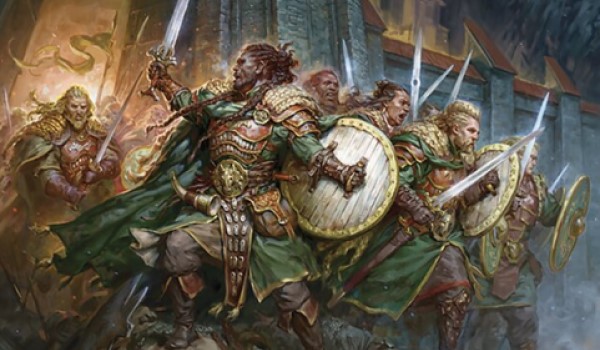Are you a Quiet Speculation member?
If not, now is a perfect time to join up! Our powerful tools, breaking-news analysis, and exclusive Discord channel will make sure you stay up to date and ahead of the curve.
It's hard not to compare Lord of the Rings: Tales in Middle Earth (LTR) to the format that preceded it, March of the Machine (MOM). From a complexity level, LTR resembles a core set. Synergies are important, and clearly guided by signpost uncommons. The power level is a nowhere near as high. While some commons do stand out, specifically Errand-Runner of Gondor, we want to make sure we're supporting them by adhering closely to the format's archetypes.

In my preview guide, I discussed my thoughts on the Jeskai tempo decks in the format. With the help of my old friend, confirmation bias, I leaned towards those archetypes to navigate this brand-new playing field. During the early-access event I was able to have a lot of success by playing the wedge's aggressive decks, especially in red.
But before plunging into that topic, I want to discuss one of the major differences between LTR and MOM.
Synergy Is Everything
The best decks in MOM got a big boost from rares. It was often worth splashing powerful bombs, even if they didn't perfectly meld with a deck's theme.
Additionally, redundant keywords work together well. For example, in War of the Spark (WAR), amass was often used to create tokens to sacrifice. Here, amass plays well with... more amass. We want our army tokens to be huge, not just measly bodies. Tempt plays well with more tempt, which is a little more intuitive.
Because of this, there is more incentive to get into the open colors, rather than to hold onto a first-pick bomb.
Hoards of lords
Early on, this format feels like it's about the uncommons. These cards enhance the effectiveness of many of our commons... though some commons can have a similar effect.
High-synergy commons
Much like in the novelized battles of Middle-Earth, the legends have a profound impact on those surrounding them. Because these cards can boost multiple archetypes, Great Hall of the Citadel becomes an interesting option to enable splashes.
Overlapping archetypes might make Old Man Willow a potent splash in a BW or GW deck. This nonbasic land splashes legends better than off-color basics. It can meet all of our off-color mana requirements while still creating a better mana base to cast on-color legends. In the early weeks, it will go much later than it should.
UR Spells
Similar to the UR Spells deck in Dominaria United (DMU), this Izzet deck focuses on tempo and aggression. The most synergistic versions of the deck play like a burn deck, but it can skew towards a more traditional aggressive deck.
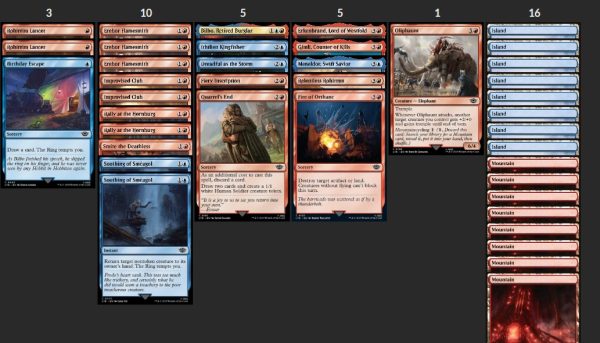
UR Spells (7-0)
The four-mana legends were underperformers in the deck. Though each is powerful, they lack synergy with the rest of the deck. They generally weren't fast enough to help with our central gameplan. Erkenbrand, Lord of Westfold was an exception. This card is bonkers with Rally at the Hornburg, and it swung games completely.
Rally thrives in this deck. It's an aggressive two mana spell, playing well with Erebor Flamesmith and Improvised Club, both of which out-performed expectations. This trio of red cards make for the cornerstone of a very aggressive color.
The powerful build-arounds incentivize a more spell-based approach. If we see those cards, they're worth taking a flyer on. Seven or so triggers are enough for Erebor Flamesmith, but Fiery Inscription is a furnace that must be fed.
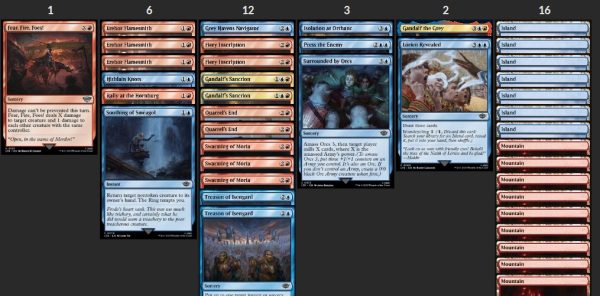
UR Synergy (7-0)
To be frank, I feel like I peaked before the format's release.
Double Fiery Inscription, triple Erebor Flamesmith, double Gandalf's Sanction, and Gandalf the Grey himself headline this five-creature opus.
This deck was all synergy. Middling cards like Swarming of Moria, Quarrel's End, and Treason of Isengard were often burn spells in addition to their stated value. Building around build-arounds means always building towards something. The UR build-arounds are definitely worth the commitment.
RW Humans
This is the other Rally of the Hornburg deck, a card that might be both the set's Gust Walker and most valuable glue card. The two haste bodies are generally good, but the fact that they can each carry Dúnedain Blade makes RW a threat at common.
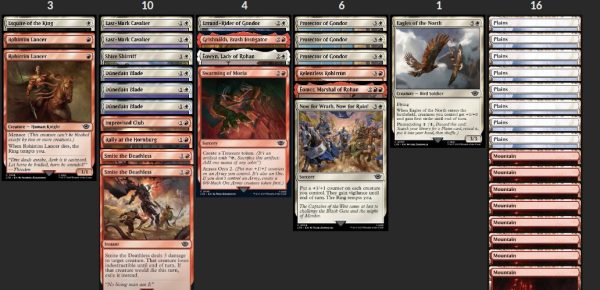
RW Humans 6-3
Rohirrim Lancer made for a decent stand-in, but what this deck wanted was more Rally of the Hornburg. Efficient creatures get a ton of value out of the cheap equip cost on Dúnedain Blade, and this trio pressures well early and into the mid-game. Protectors of Gondor provides redundancy once we're going in this direction.
Improvised Club may be the Price of Loyalty of this set. It's the secret sauce to the format's aggressive decks, and this is probably its best home. This deck makes a lot of bodies and some of them end up chump attacking. Club is a versatile tool that provides needed reach to the RW decks.
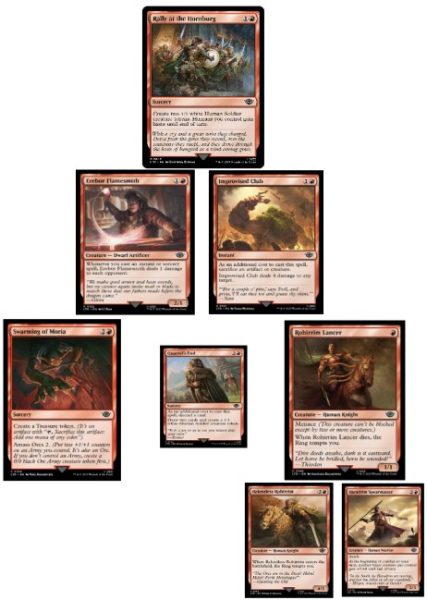
Through the power of Microsoft Paint, I've outlined a synergy triangle between the red commons of RU and RW. Rally the Hornburg is a cornerstone of both decks.
UW Draw Two Aggro
This was the deck I was most excited about. However, it doesn't have access to the aggressive starts of the red decks. I anticipated The Ring to be active enough in this archetype to fuel the "draw two" payoffs while applying aggressive pressure.
White and blue are a little more midrange than I predicted. Turning on The Ring is not trivial, and the format has a lot of one-power blockers. In my first draft of the format, I first-picked an Prince Imrahil the Fair and aimed at the UW aggro deck I expected to dominate the format.
Blue Streak
In my draft, I prioritized power level where I was supposed to prioritize cheap tempt triggers. Slip on the Ring and Birthday Escape may have played better than Saruman the White and Boromir, Warden of the Tower. Those cards would have empowered my swarm of middling cheap creatures and enabled more aggressive gameplay.
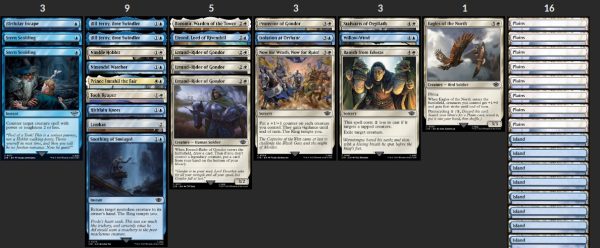
UW Tempo (3-3)
This deck was great when it drew Prince Imrahil the Fair and Errand-Rider of Gondor, but pretty bad when it didn't draw either. The two-drops aren't given enough support and the five-drops aren't positioned to synergize with them. Errand-Rider of Gondor cures a lot of ills though. I think this deck is supposed to be built to set up an active Ring-bearer and generate value with it through the mid-game.
Building a Better UW
The better UW decks are going to play a slower game. Blue has tons of card draw, and reasonable support for it in Pelargir Survivor.
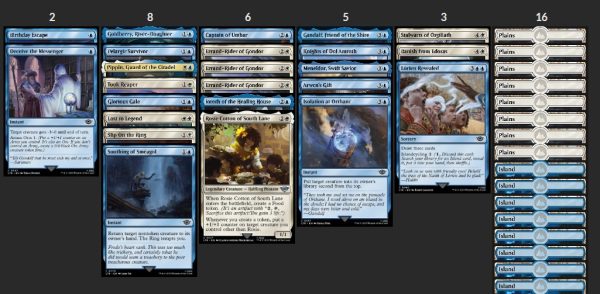
Bigger UW (7-2)
This deck more closely aligns with what the blue commons are trying to achieve. It tempts better. It plays more individually powerful cards and leans into the ample card advantage blue offers. Because the format feels very sorcery-heavy, cards like Slip on the Ring, Deceive the Messenger, and Gandalf, Friend of the Shire are all easier to use. The Melendor, Swift Savior and Errand Rider of Gondor combo is very real as well.
For the Shire!
So far, the format has been a blast. Despite boasting a lower power level, it has felt very skill-intensive, and sequencing is extremely important. My prediction was that Jeskai would be the tempo wedge, but ultimately I think the red decks are where aggression lives. BR has felt really powerful and might be the best deck in the format. Still, it's very early. So let me know what you think of the format in the comments! Until next week... I'll be drafting.


